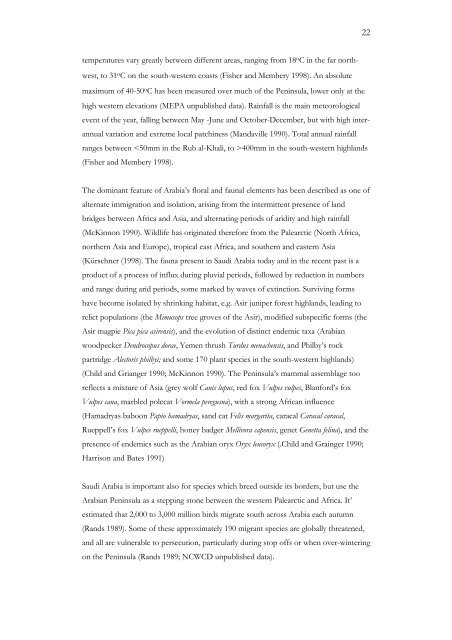The Unfenced Desert Towards a strategy for eco ... - Nwrc.gov.sa
The Unfenced Desert Towards a strategy for eco ... - Nwrc.gov.sa
The Unfenced Desert Towards a strategy for eco ... - Nwrc.gov.sa
Create successful ePaper yourself
Turn your PDF publications into a flip-book with our unique Google optimized e-Paper software.
temperatures vary greatly between different areas, ranging from 18 o C in the far north-<br />
west, to 31 o C on the south-western coasts (Fisher and Membery 1998). An absolute<br />
maximum of 40-50 o C has been measured over much of the Peninsula, lower only at the<br />
high western elevations (MEPA unpublished data). Rainfall is the main meteorological<br />
event of the year, falling between May -June and October-December, but with high interannual<br />
variation and extreme local patchiness (Mandaville 1990). Total annual rainfall<br />
ranges between 400mm in the south-western highlands<br />
(Fisher and Membery 1998).<br />
<strong>The</strong> dominant feature of Arabia’s floral and faunal elements has been described as one of<br />
alternate immigration and isolation, arising from the intermittent presence of land<br />
bridges between Africa and Asia, and alternating periods of aridity and high rainfall<br />
(McKinnon 1990). Wildlife has originated there<strong>for</strong>e from the Palearctic (North Africa,<br />
northern Asia and Europe), tropical east Africa, and southern and eastern Asia<br />
(Kürschner (1998). <strong>The</strong> fauna present in Saudi Arabia today and in the recent past is a<br />
product of a process of influx during pluvial periods, followed by reduction in numbers<br />
and range during arid periods, some marked by waves of extinction. Surviving <strong>for</strong>ms<br />
have b<strong>eco</strong>me isolated by shrinking habitat, e.g. Asir juniper <strong>for</strong>est highlands, leading to<br />
relict populations (the Mimusops tree groves of the Asir), modified subspecific <strong>for</strong>ms (the<br />
Asir magpie Pica pica asirensis), and the evolution of distinct endemic taxa (Arabian<br />
woodpecker Dendrocopus dorae, Yemen thrush Turdus menachensis, and Philby’s rock<br />
partridge Alectoris philbyi; and some 170 plant species in the south-western highlands)<br />
(Child and Grianger 1990; McKinnon 1990). <strong>The</strong> Peninsula’s mammal assemblage too<br />
reflects a mixture of Asia (grey wolf Canis lupus, red fox Vulpes vulpes, Blan<strong>for</strong>d’s fox<br />
Vulpes cana, marbled polecat Vormela peregusna), with a strong African influence<br />
(Hamadryas baboon Papio hamadryas, <strong>sa</strong>nd cat Felis margarita, caracal Caracal caracal,<br />
Rueppell’s fox Vulpes rueppelli, honey badger Mellivora capensis, genet Genetta felina), and the<br />
presence of endemics such as the Arabian oryx Oryx leucoryx (.Child and Grainger 1990;<br />
Harrison and Bates 1991)<br />
Saudi Arabia is important also <strong>for</strong> species which breed outside its borders, but use the<br />
Arabian Peninsula as a stepping stone between the western Palearctic and Africa. It’<br />
estimated that 2,000 to 3,000 million birds migrate south across Arabia each autumn<br />
(Rands 1989). Some of these approximately 190 migrant species are globally threatened,<br />
and all are vulnerable to persecution, particularly during stop offs or when over-wintering<br />
on the Peninsula (Rands 1989; NCWCD unpublished data).<br />
22

















